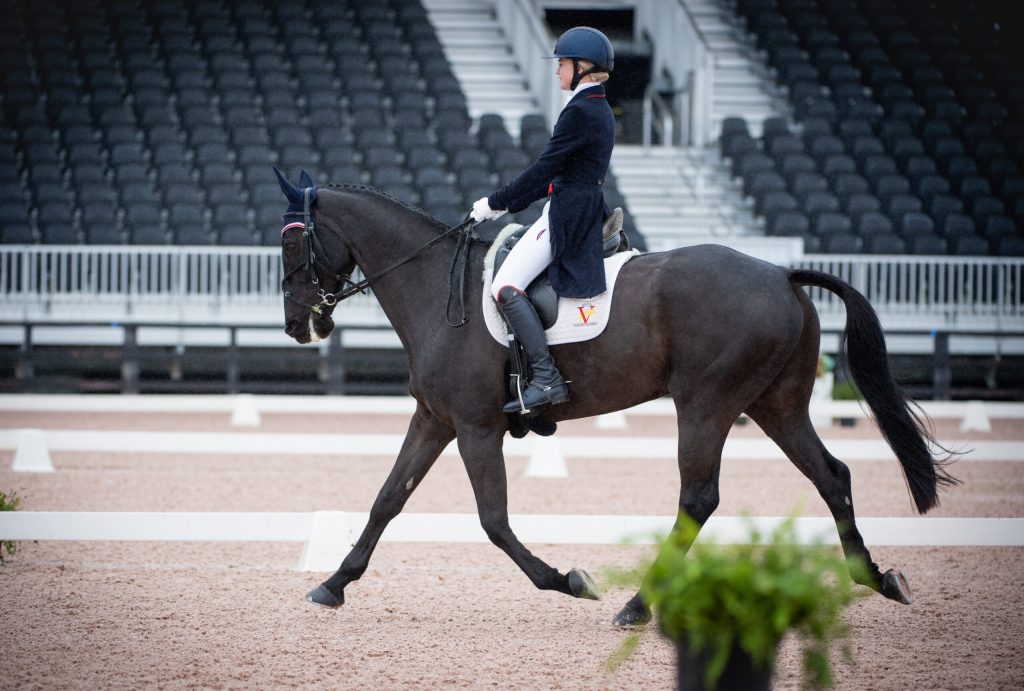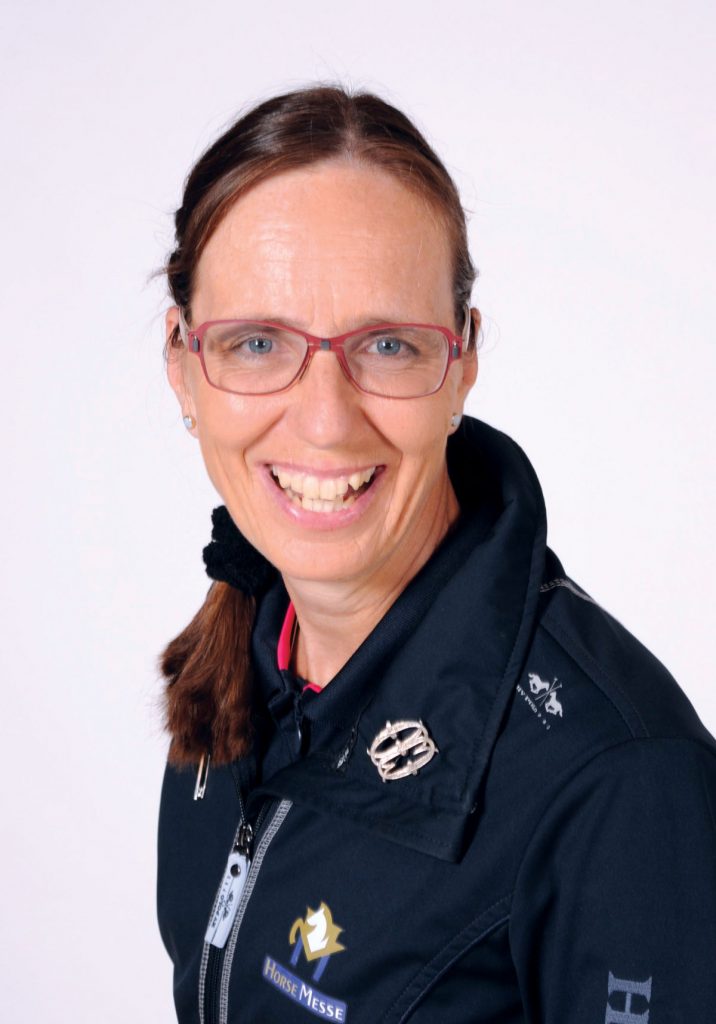This photograph shows Zara Flores-Kinney and Elusive Dassett, a 12-year-old KWPN gelding, during the dressage test of a CCI3*-L eventing competition. Their dressage test is the equivalent of a Second/Third Level dressage test. Zara has been training with Elusive Dassett for four years.

Alleyn Evans for Shannon Brinkman Photography
One can see in the photo that these two know each other, and that they trust each other, too. This is the most important foundation for a successful partnership in eventing. Zara is very focused and as a result is looking slightly down.
I can see by her noseband choice and bit that the horse probably has a lot of “go,” and it may be a challenge to keep the effort all together in a dressage test.
Lifting Shoulders and Self-Carriage
Zara’s seat in this trot extension reminds me a bit of the safety seat when landing off a drop jump. Her leg is on, her hands are giving forward and her upper body is leaning back slightly to stay in balance. Of course I am exaggerating, but this was the thought that popped into my mind when I started to analyze the photo.
By closing her legs and leaning her upper body slightly back, Zara is attempting to push the horse forward with her seat. But the direction of her push is down to the forehand. I notice that the horse is extending his front leg using more of the muscles of the lower neck and shoulder instead of lifting the shoulders with self-carriage from the topline. With a little more lift of the shoulders and self-carriage, Elusive Dassett would not need as much balance help from Zara’s hands. Zara shows a very high level of feel in the way she supports with her hands. She is moving her hands forward while providing the necessary contact for her horse.
Elusive Dassett is moving in the extension using his legs a bit more than his body. Improving self-carriage and balance in transitions into and out of the extensions will be an important goal to achieve a higher quality of movement in the test.
After that initial push forward of her seat bones, Zara needs to practice immediately bringing her shoulders into alignment with her hips again. Ideally, the horse should follow her upper body moving slightly forward into the extension. Then it will be easier for Zara to relax the hip joints and keep her legs supple. Her legs will be more supporting and less holding on the horse’s sides during the extension. A supple hip joint will allow a supple ankle. Only then can she ride the extended trot with an “extended” seat stretching up through her spine and down through her legs.
As a rider, we often think “forward” for the extension, and this makes it flat and hurried. We need to always add the third dimension. This is imagining that the movement must contain a fair amount of lift for enhancing balance and quality inside the movement. When starting the extension, the rider’s aid should not only be asking for forward, but also thinking more up and then forward. This requires the rider to use her abdominal muscles to stabilize her core. She also needs to bring her own center of gravity a little up and then forward together with the response and movement of the horse.
An Exercise for Balance
To improve the balance and self-carriage in the extended trot, I recommend the following exercise:
Ride a balanced working trot and feel that this trot is establishing a “comfort zone.” You can call this trot “Number 3.” To improve balance, one needs to get out of the comfort zone, but always with the security and trust to be able to find the way back.
Start by slowing the horse down to a Number 2 trot and then back to the Number 3 comfort zone. Then add a little more power and find the Number 4 trot. Return back to the Number 3 and start adding transitions to Number 1 and Number 5. Keep in mind that Number 5 is not the maximum trot, and before the Number 1, trot half-steps could be possible.
Remain at each number for the same number of strides until you can ride, for example, four strides within each number from 1 to 5 and back to 1. This exercise is an effective way to teach horse and rider that while extending, one needs to work for collection, and when collecting, we need to keep riding forward. The Number 3 trot must always feel the same, whether the next number is higher or lower.
The gradual change of trot tempo will ensure that horse and rider stay balanced and connected. Once this task can be ridden like a crescendo (gradually increasing) and decrescendo (gradually decreasing) in music, you can start mixing the numbers a little bit. For example, to improve the extension one can start with: 1-2-3-4-5-5-4-3-2-1 and then start playing: 1-2-3-2-3-4-3-4-5-5-4-5-4-5-4-3-2-1.
In this way, every time the horse is pushed forward to the next higher number, he will have to listen to come back for one or two strides before moving up again. This enhances elasticity and stability and teaches him to wait for the rider’s aids in the extensions.
For Zara, the quick interchange of aids during these exercises will automatically challenge her upper-body balance. It will help her find a better middle position and uprightness because only out of this mid-position can she react quickly enough to support her horse. She will be able to feel more lightness in her contact and will be able to communicate with more effective and less-visible aids.
I am sure that working on those tiny, gradual transitions will improve the overall quality of movement for Elusive Dassett and enable Zara to score higher in her dressage tests.
Wishing them many happy rides together and successful eventing!

Susanne von Dietze is a leader in equestrian biomechanics. A physiotherapist, licensed Trainer A instructor and judge for dressage and show jumping, she gives lectures and seminars throughout the world, including at the prestigious German Riding Academy in Warendorf. She is a native of Germany and now lives with her husband and three children in Israel, where she competes at the international level. She is the author of two books on the biomechanics of riding: Balance in Movement and Rider and Horse, Back to Back.
This article originally appeared in the Fall 2022 issue of Practical Horseman.
Subscribe To Our Newsletter
Are you wondering about the best deals on equine veterinary services and products? Join our newsletter!First Name Last Name Email
I agree to the Privacy Policy & Terms of UseSUBSCRIBE










